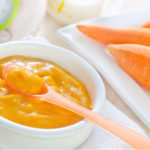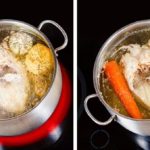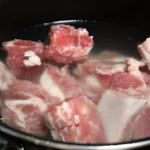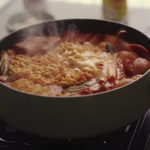Many people wonder why bones often froth when boiling, even when they have thoroughly cleaned the ingredients. Does the froth indicate the presence of residual chemicals in the rearing or preservation process?
Causes of frothing bones
Meat consists of two main components: protein and fat, in addition to water, carbohydrates, and other substances. When bones are simmered or meat is boiled, these substances, along with excess blood and dirt on the surface of the meat, are released, creating a frothy phenomenon.

Why do bones froth when boiling? (Photo: Mosaic Lille)
According to Associate Professor Nguyen Duy Thinh, former lecturer at the Hanoi University of Technology, the froth that appears when boiling meat or simmering bones is not a sign that the meat or bones contain toxins or that the pigs raised contain chemicals.
The froth is the amount of dissolved protein in the water, which then coagulates and rises when the water begins to boil. The froth may contain some dirt from the meat and bones. “During the slaughtering, transportation, and storage processes, the meat and bones come into contact with dust, soil, and sand, but it cannot be affirmed that the meat is contaminated with chemicals,” Thinh said.
Knowing the reason why frothing occurs when boiling bones does not indicate chemicals, should you remove the froth? The answer is yes, because when protein precipitates, any remaining dirt in the food also coagulates and sticks to it. However, you only need to skim off the first wave of froth when they show signs of overflowing, and the subsequent layers of froth do not need to be skimmed off because the dirt has already been removed.

The second layer of froth contains a lot of bone protein and fat, so it doesn’t need to be skimmed off (Photo: Umami Days)
To remove dirt from bones when you first purchase them, it is best to wash them with diluted salt water and then rinse them under clean running water before placing them in the pot and adding water.
Quick tips for simmering bones and making broth
Depending on the quantity and type of bones and whether you are reusing the bones or not, we can adjust the simmering time. In general, to cook delicious and tender bone broth quickly, follow these steps:
– Cut the bones into bite-sized pieces, then rinse and soak them in diluted salt water for about 30 minutes to remove any unpleasant odor. Rinse them again with clean water to remove excess blood and retain important nutrients, which will make the bone broth more fragrant and flavorful.
– Place the bones in a pot with cold water, bring to a boil, flip them over, then remove and rinse them. If you put the bones in boiling water, the bones and dirt will contract immediately when exposed to heat, causing many impurities in the bone marrow not to be released and float to the surface. This will make the bone broth cloudy and smelly throughout the simmering process.
– Start simmering the bones in boiling water over low heat for about 1 hour. When the simmering is sufficient, add vegetables and then salt. Adding salt at this point will make the broth clearer.
Dealing with cloudy broth
If the broth becomes cloudy, you can try the following methods to deal with it:
– Crack an egg white into a bowl, beat it, then pour it into the broth and stir continuously. After a few seconds, the black specks will mix into the egg white. At this point, you can skim off the egg white, and the broth will become clear.
– Add some dried mushrooms or raw potato slices to the broth.
– For chicken bone broth, add fresh chicken bones and continue simmering; the broth will become much clearer.
Source: VTC news
Revealing the Secret to Making Delicious and Odorless Bone Broth
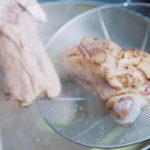 Broth‘>
Broth‘>Enhance your dishes with a simple step! Roasting salt and adding it to a steaming pot of bone broth creates an intense flavor that will elevate your meals to the next level. Enjoy a clear, rich broth perfect for any dish.

























